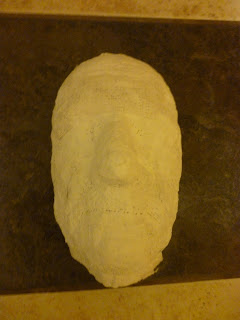Merry Christmas fellow bloggers. Hope Ye're all enjoying the holidays. I know some people may be wondering why I'm making a post at this point, when I should be chillin'. Well I'm not trying to earn brownie points or anything like that, it's because my computer is playing up any I want to ensure my work to date is recorded. When you think about it these posts are an extra back-up. So I might as well bring things up to date regarding my project. Before the holidays I was working on a 3D piece composed of a paper sculpture which represents the space I occupy. It looks rather skeletal which is fine as I had never intended to portray a solid figure. There is also a degree of transparency, which I was also going for so although I didn't get to complete it I'm happy with the result. Feel free to give some feedback (critique), it's valuable to me either way.
The images show a progression of the construction process. The upper torso area is based on a rib cage which gave the initial impression of a skeleton, so I think the addition of limbs in a more cylindrical form alters this. Although light, the sheer volume of paper, and eventual position - suspended - required a 2.5mm wire armeture. This actually worked out well as the 'face' ended up being cast in wax, as opposed to my original intention of fibreglass, which I believe is lighter and may have been supported by paper. My reason for suspending the piece was the result of my research into 'sensing' one's space. Recalling from personal experience the sensation felt when floating on water, i.e. dead mans float, of being totally relaxed, drifting, oblivious, and yet aware of your position in relation to your surroundings (especially the shore). Without deliberately trying you sense what's around you - the space available to you. Thinking along this line I remembered seeing something similar in a movie that involving body suspension in mid air. The film is called 'A man called horse' starring Limericks own Richard Harris (coincidence?) and part of the plot involves Harris's mid-air suspension as part of his initiation into a Native American tribe.
Body suspension originates from Native American and Hindu culteres. The practice has been going on for thousands of years as rites of passages, healing rituals and as a means of leaving the body and entering the spiritual realm. One notable native American ritual is the Sundance, in which the person is pierced through the chest and attached to a sacred tree. The person then pulls and dances until the piercing rips free. After the trance, when he is free from the hooks, he is also free from the prison of the physical limitations, he is reborn, like the sun.
My interpretation of this ritual is that during the trance-like, meditative state induced by the ceremony, the person is still aware of (sensing), thier space.
In today's world there is a movement emerging among adepts of body art and body modifications which aims to revive the spiritual experiences of the primitive tribes by performing rituals such as body suspension and body piercing. Many people who have gone through the experience state that the pain is easily overcome by the sensation of being above the physical senses.
Had I managed to finish this piece, or at least the other leg, I'd intended to suspend it from six points, as seen in modern day practice. If you can imagine, two opposite points on the upper chest, two on the mid-torso and one on each thigh. The reason behind this is more to do with the chosen title. Each suspension wire, or string, would be anchored to the piece through a hole drilled in a one cent coin, secured underneath the framework. Have you worked it out yet? The title of the piece was to be - " The six cent's" (sixth sense) - I know, sometimes I even amaze myself !
Before I sign off, and go and relax (suspension ?), I'm just going to show you a few images of a variation of this piece. If you noticed the leg form in the previous blog, made in a similar style, these are some images of how that has developed.

For this piece I used newspaper, which is fine, but a few things need to be considered for future attempts. Printed newspaper can leave your hands fairly black, which can transfer onto the work. I also used 'discount store' masking tape which began to unravel the following day - it's worth paying more for decent tape. I also invested in a hot glue gun which saves time but joints are prone to opening again after movement so a more rigid composition works best. Anyway, that's all for now - I'm off for a float in the bath, but before I do I'd like to wish ye all a Happy new Year.















































